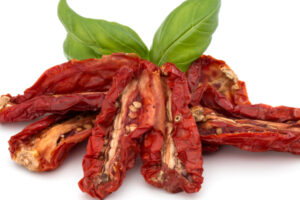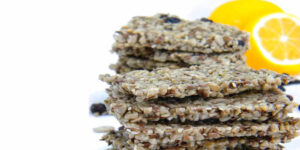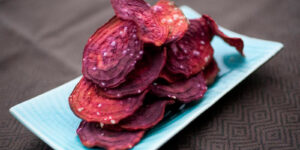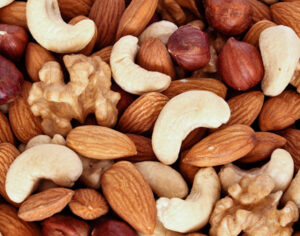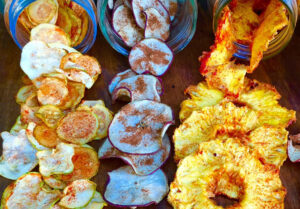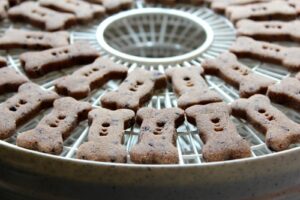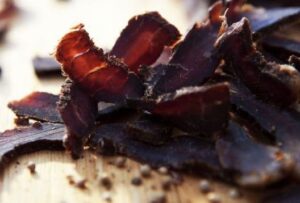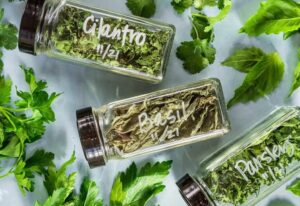All About Food Dehydrators
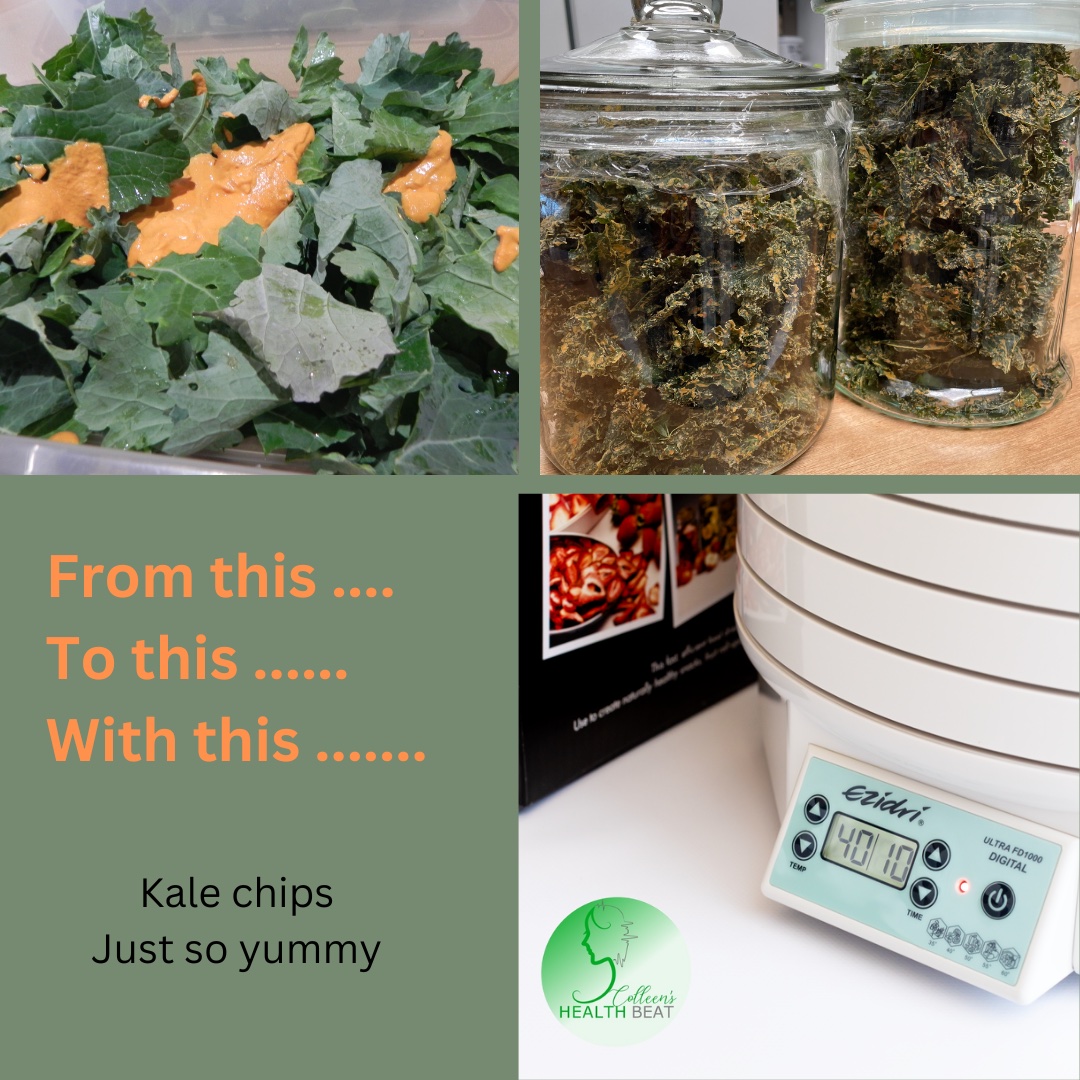
Food dehydrators are kitchen appliances that use a low-temperature system to remove moisture from foods and other materials that require dehydration. A food dehydrator can therefore create kale chips, crackers, dried fruit and vegetables, and biltong as examples of foods that can be made in a food dehydrator. Foods dry at a constant temperature over a number of hours. They work by circulating dry, warm air around the food to evaporate the moisture, allowing the food to be preserved for longer shelf life.
Some benefits of using food dehydrators include:
Preserving the nutritional content of the food without the need for added preservatives or chemicals
Increasing the shelf life of foods, and reducing waste. Dehydrated foods store well when stored in an airtight container and can last for a long time. Greens however do lose their colour over time unless they are frozen after dehydrating
Allowing for easy storage and portability of foods, making them ideal for camping or travelling
Producing flavourful and healthy snacks like dried fruits, biltong, and vegetable chips without chemical additives like flavouring, preservatives and colouring
Saving money by buying foods in bulk and dehydrating them for later use
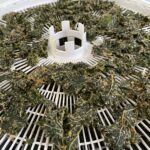
Preserving your excess vegetable harvest

Save money by preparing your own hiking meals and camping snacks
Prepare dried herbs that are not irradiated
Fruit tastes sweeter, herbs more pungent and crisp, which means that as the foods dry the flavours intensify.
Food dehydrators can range in size, shape, price, and use, some being for household use only and others can be used commercially.
Inexpensive ‘supermarket-type’ dehydrators
These dehydrators are usually round, do not have temperature control and timers, are not repairable, and do not have the option of non-stick trays for liquid or mesh sheets for drying smaller materials such as herbs and cut-up strawberries. In tests that I have done with this type of dehydrator, the drying temperature is either too low to dehydrate, or the foods burn.
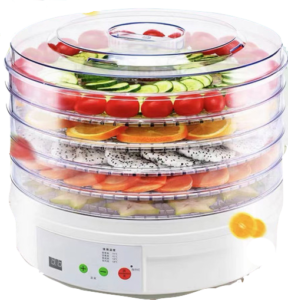
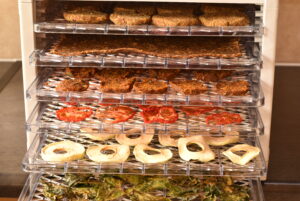
Kuto dehydrator
This is a 6-tray unit, with almost square racks. It is sold with one solid tray and one mesh sheet. Optional extra trays, non-stick sheets, and mesh sheets are available. The Kuto has a built-in timer, and temperature setting that range from 35-70 °C in 5° increments. The unit is not expandable and the unit is repairable.
Ezidri Ultra Digital dehydrator
This is a round dehydrator that is supplied with one solid sheet and one mesh sheet. The Ezidri dehydrator can be expanded from the supplied 5 trays to 30 trays (depending on what is being dried, meaning that 30 trays could be used for drying herbs and fewer depending on the liquid density of what is being dried). The faceplate is digital with settings for timing up to 19.5 hours and temperature settings from 30-70°C in 5° increments. The Ezidri can be used for both household and commercial use. The key feature of the Ezidri dehydrator is the incredible airflow design which ensures that there is no cross-contamination. This means that you can dehydrate onion and strawberries at the same time.
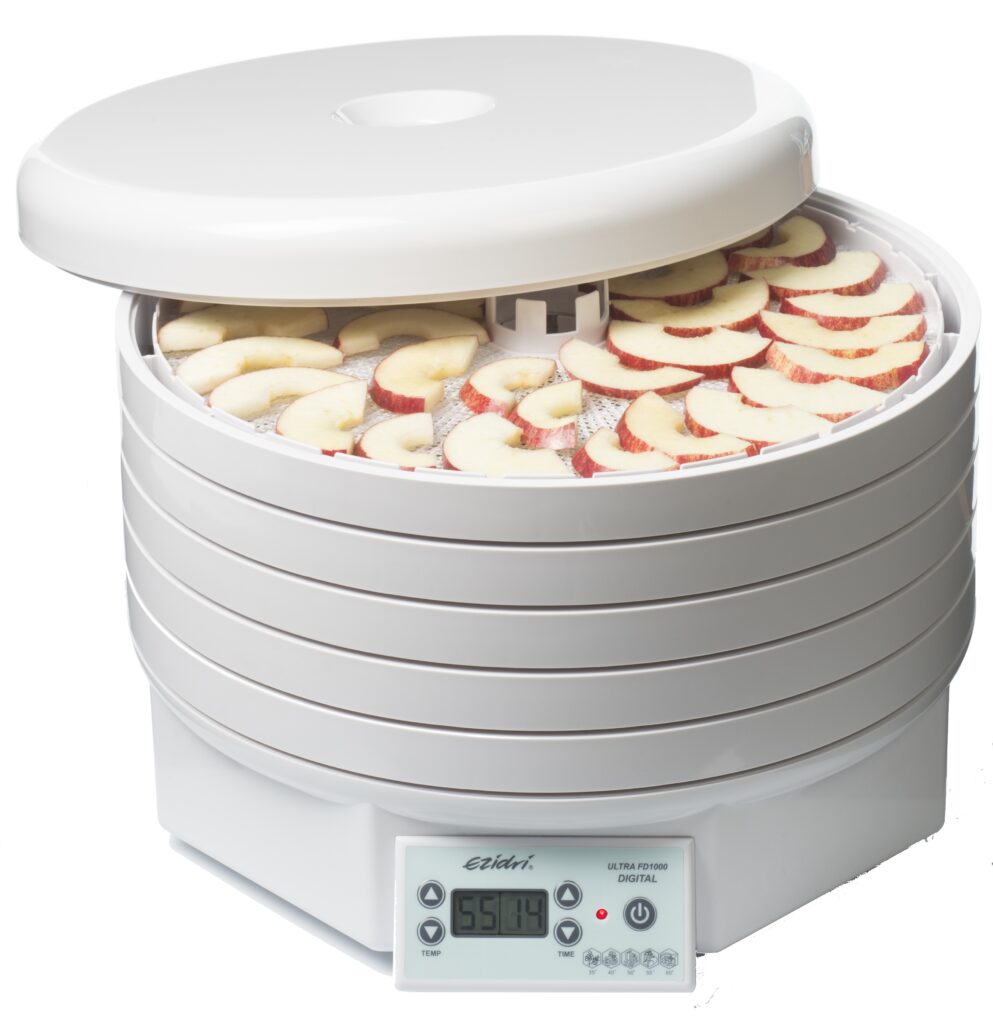
What can you dehydrate?
- Fruits: Apples, bananas, strawberries, mangoes, and more
- Fruit leather – a non-stick tray or sheet is required for this
- Vegetables: Tomatoes, carrots, peppers, zucchini, and more
- Meats and fish: And more
- Herbs: Rosemary, thyme, parsley, cilantro, etc., avoiding irradiated shop-bought herbs
- Dried flowers: Easiest way of bulk drying with controlled temperature
- Hiking and camping: Full meals and snacks can be dehydrated
- Crafts and DIY: A food dehydrator is an excellent tool for creating decorative dried flowers and fruits such as orange slices, and crystallised fresh flowers for cake decor, potpourri, flour, and water molds to be painted, Etc.
- Snacks: Granola bars, crackers, nuts, kale chips, Etc.
- Pet Treats: Create inexpensive treats for cats, birds, and dogs using quality ingredients
- Dry homemade pasta
- Ferment yoghurt – Slow process at 30°C for about 14 hours
Retention of nutrients
When dried at low temperatures, the nutrients are retained far more than most cooked foods. Foods that contain vitamin C, which is water soluble, lose the benefits of the vitamin when boiled. Dehydrated snacks made at home tend to be much healthier than store-bought snacks; they contain whole food ingredients and avoid additives like preservatives and colouring and you can limit oil and sugar to suit yourself.
Overall, food dehydrators are a great investment for those who want to enjoy healthy and flavourful foods year-round, or as a useful and time-saving tool to create crafts and decorate cakes.
How dehydrators work
Dehydrators dry by moving warm air and expelling moist air. The contents to be dried should be arranged in such a manner that they are not piled up on top of each other, and each type of produce is are cut into equal thicknesses. This will ensure that they dry evenly.
Temperatures should be set according to the moisture content, density, size, and type of food or item being dehydrated.
Not all dehydrators work in the same manner. Some push air across the trays from the back, and the Kuto dehydrator is an example of this type of airflow. Others, particularly the cheap dehydrators blow air from the bottom through all the trays to the top. This type requires you to move the trays around during dehydration to ensure that they all dry evenly. Then you have the Ezidri dehydrator which has a very special method of airflow.
The airflow of the Ezidri dehydrator
Although the air flows from the bottom, it does not blow from one tray to another. The air flows up channels around the perimeter of the trays, and across each try to the central chimney which carries the moist air out. This ensures that each tray gets and equal amount of warm dehydrating air and there is no cross-contamination, meaning that if you dried onions on a lower tray and strawberries on a higher tray, the strawberries would not smell like onions.
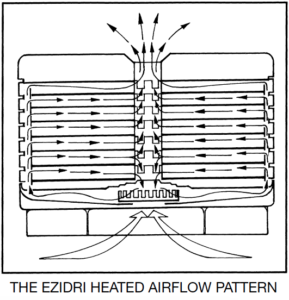
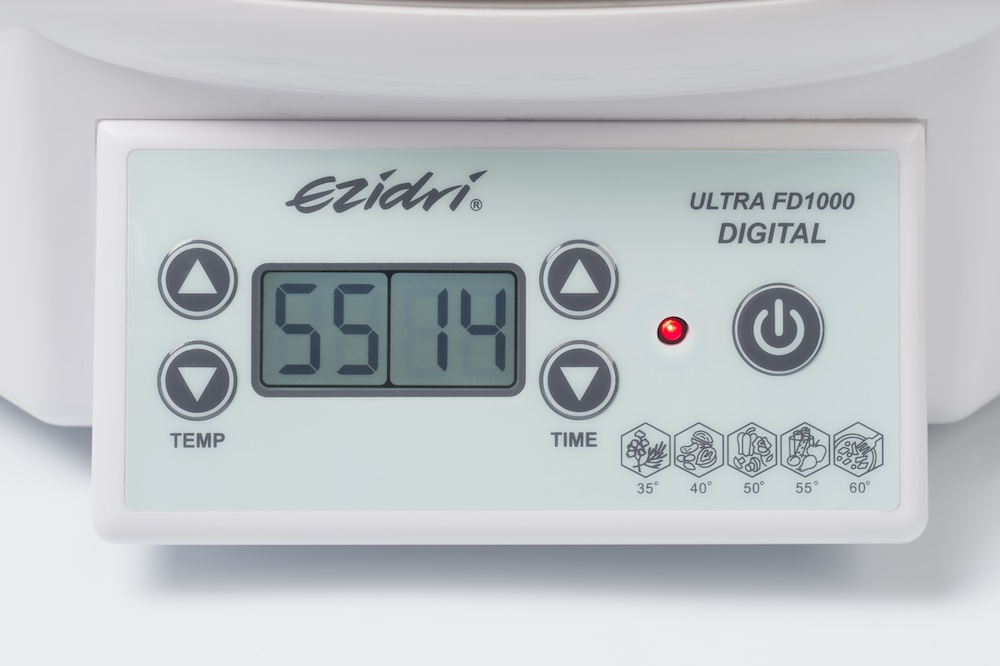
Temperature setting and timers for dehydrators
Most dehydrators offer a temperature range of 35-70°C. Some settings are set manually and others are set digitally. In my experience in testing a variety of dehydrators the actual temperatures of the cheap dehydrators are not always reliable. I have found the food to burn or to hardly dehydrate.
Both the Kuto and the Ezidri dehydrators have built-in timers. The Kuto can be set to anything from 30 minutes to 19.5 hours, in 30-minute increments. The new digital Ezidri dehydrator’s timer is in 1-hour increments and can time up to 48 hours.
Cheap dehydrators do not usually have a built-in timer.
Selecting temperatures for different produce and materials
Most quality dehydrators will have a chart in the manual, however, a general rule would be to use a lower temperature for herbs that are delicate, and medium heat at 45° for foods that you want to remain ‘raw’ where the enzymes are not damaged. High-liquid produce, where you are not specifically concerned about the ‘raw’ status, should be dehydrated at higher temperatures to efficiently remove the liquid. Biltong should be dehydrated initially at 70° and can then be dropped to 60°.
Homemade Biltong – Dehydrator
Comparing dehydrator designs
There are two main types of dehydrators. Those with round trays that stack and those with pull-out shelves that are usually square or almost square.
Other than personal preference for the shape of the trays /shelves, the main advantage in the case of the Ezidri dehydrator is that additional trays can be purchased taking the standard 5-tray unit up to 30 trays. Cheap dehydrators with round trays cannot be expanded.
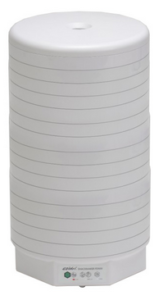
Can you use an oven as a dehydrator
A dehydrator with it’s specifically low temperatures and multiple trays or racks is the ideal design for drying foods, whereas most ovens are unable to be set at such low temperatures as their design is to cook food and the limited racks are also not cost effective to run the oven for long periods of time.
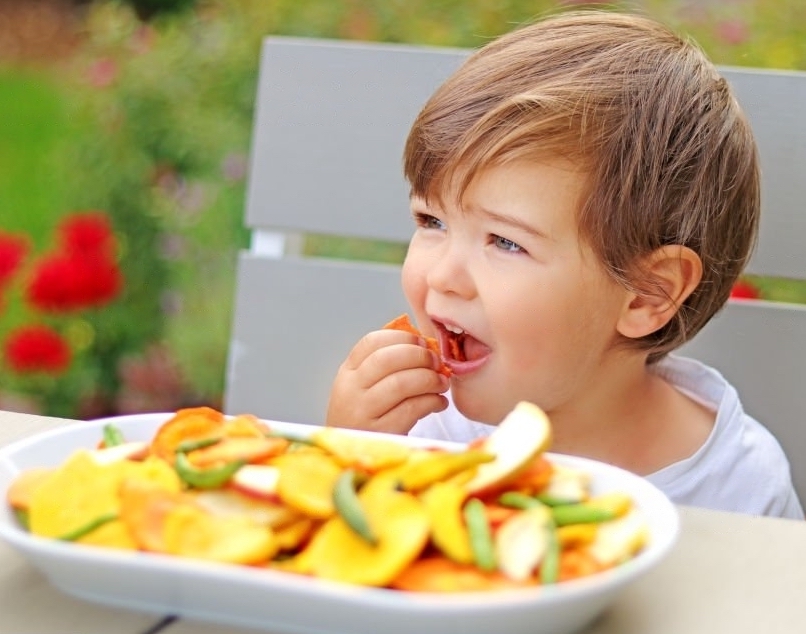
Is it worthwhile to invest in a dehydrator?
When one thinks about the benefits of the tasty healthy snacks that can be made with a dehydrator, and what value they are to our health. Ingredients for these snacks are all fresh produce and nutritious seeds and nuts.
To be able to preserve homegrown harvest for later use, and take advantage of bulk buying of in-season produce, the dehydrator is a great asset. It is well documented that dehydrated produce has the least amount of nutrient loss of any preservation method.
Some of the ways I used my dehydrators
I personally have an Ezidri and a Kuto dehydrator, and find them so useful in enhancing my health, by being able to have nutritionally dense snacks, which when bought are usually quite costly. When my homegrown produce is more than we can eat I find interesting and tasty ways of preserving them with my dehydrators. I love nuts and to remove the enzyme inhibitors, I soak the nuts and dehydrate them which makes them much more digestible. My dogs love the treats I make for them on the dehydrator. This allows me to select the healthy ingredients that they deserve. Whenever I can obtain bulk buys of fruit and veg I use my dehydrators as one of the methods I use to preserve the produce.
I love my dehydrators and find that they form an integral part of my healthy lifestyle.
Are there any accessories available?
Cheap dehydrators do not offer any accessories. The Kuto dehydrator offers additional solid trays, mesh sheets and non-stick cloth sheets. the Ezidri dehydrator offers additional trays, spacers, solid sheets, mesh sheets and non-stick cloth sheets.
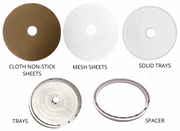
Finally! Check that the dehydrator that you buy is repairable, and is there a warranty?
Certainly, the Kuto and Ezidri dehydrators that have been trusted names in dehydrators for many years are repairable, if in the unlikely event of them failing. They both come with a warranty and the Ezidri, although popular as a household dehydrator is suitable to be used commercially when additional trays are purchased.
